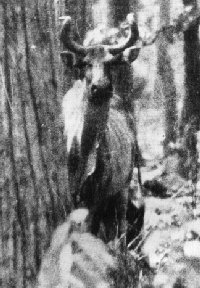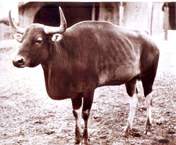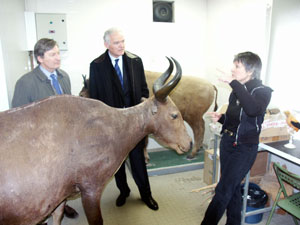
September 12, 2007

One of the first photographs taken in the wild of the elusive kouprey.
Kouprey (Bos sauveli), a wild forest-dwelling ox, was discovered in 1937. (Indeed, the kouprey is discussed as an animal of discovery in cryptozoology, on page 128, here.)
Cryptomundo has discussed the ongoing debate about the reality of the kouprey here before.

This photograph (above) was taken in 1937 of a kouprey at the Vincenes Zoo, Paris; the animal died in 1940.
Nature, 449, 124 (13 September 2007) has published in their “Advance Online Publication” of September 12, 2007, the breaking news that the Kouprey (Bos sauveli) has been found to be a separate species. In Ewen Callaway’s “Mystery ox finds its identity: Near-extinct kouprey reclassified as distinct species,” the item notes:
The kouprey, an enigmatic Asian ox believed to be a hybrid — and so, unworthy of conservation efforts — is in fact a distinct species related to the banteng (a wild ox) [1]. The conclusion contradicts earlier findings [2] that the horned beast is a cross between the banteng and domesticated zebu cattle.
First identified in 1937 and last spotted in the 1980s, the kouprey (Bos sauveli) has become a symbol for conservation in southeast Asia. Some experts think that it is already extinct.
Gary Galbreath, a biologist at Chicago’s Field Museum in Illinois who concluded that the kouprey was a hybrid, told CBS News: “It is surely desirable not to waste time and money trying to locate or conserve a domestic breed gone wild.” He based that conclusion on the observation that kouprey and banteng (Bos javanicus) shared several sequences of mitochondrial DNA.
Now, Alexandre Hassanin and Anne Ropiquet of the National Natural History Museum in Paris have sequenced three regions of mitochondrial DNA and five of non-coding nuclear DNA from seven related species, including kouprey.
The pair found that kouprey have unique sequences of both mitochondrial and nuclear DNA. Their data suggest that kouprey should indeed be a conservation priority — if anyone can find one.Mystery ox finds its identity by Ewen Callaway
Sources: 1. Hassanin, A. & Ropiquet, A. Proc. R. Soc. B doi:10.1098/rspb.2007.0830 (2007). 2. Galbreath, G. J., Mordacq, J. C. & Weiler, F. H. J. Zool. 270, 561–564 (2006).

The above pictured kouprey is the misidentified animal that arrived at the menagerie of the botanical garden of Paris in 1871. After its death, it was mounted and placed in the Natural History Museum of Paris, before being entrusted in 1931 to that of Bourges. Its heading: “Ox of Kampuchea, gift of the Minister for the Navy.” (Kampuchea is another name, used by some, for Cambodia.)
About Loren Coleman
Loren Coleman is one of the world’s leading cryptozoologists, some say “the” leading living cryptozoologist. Certainly, he is acknowledged as the current living American researcher and writer who has most popularized cryptozoology in the late 20th and early 21st centuries.
Starting his fieldwork and investigations in 1960, after traveling and trekking extensively in pursuit of cryptozoological mysteries, Coleman began writing to share his experiences in 1969. An honorary member of Ivan T. Sanderson’s Society for the Investigation of the Unexplained in the 1970s, Coleman has been bestowed with similar honorary memberships of the North Idaho College Cryptozoology Club in 1983, and in subsequent years, that of the British Columbia Scientific Cryptozoology Club, CryptoSafari International, and other international organizations. He was also a Life Member and Benefactor of the International Society of Cryptozoology (now-defunct).
Loren Coleman’s daily blog, as a member of the Cryptomundo Team, served as an ongoing avenue of communication for the ever-growing body of cryptozoo news from 2005 through 2013. He returned as an infrequent contributor beginning Halloween week of 2015.
Coleman is the founder in 2003, and current director of the International Cryptozoology Museum in Portland, Maine.
Filed under Breaking News, Cryptotourism, CryptoZoo News, Cryptozoologists, Cryptozoology, Expedition Reports, Extinct, Forensic Science, New Species